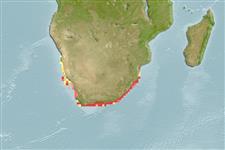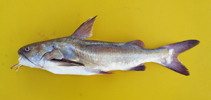Galeichthys feliceps Valenciennes, 1840
White barbel
Ajouter votre observation dans Fish Watcher
| Native range | All suitable habitat | Point map | Year 2050 |

|
| This map was computer-generated and has not yet been reviewed. |
| Galeichthys feliceps AquaMaps Data sources: GBIF OBIS |
Envoyez vos Photos et vidéos
Pictures | Images GoogleGaleichthys feliceps
Picture by Alvheim, O./Institute of Marine Research (IMR)
Pictures | Images GoogleGaleichthys feliceps
Picture by Alvheim, O./Institute of Marine Research (IMR)
Common names from other countries
Classification / Names Noms communs | Synonymes | Catalog of Fishes(Genre, Espèce) | ITIS | CoL | WoRMS | Cloffa
> Siluriformes (Catfishes) > Ariidae (Sea catfishes) > Galeichthyinae
Etymology: Galeichthys: Greek, galeos = a shark + Greek, ichthys = fish (Ref. 45335).
More on author: Valenciennes.
Etymology: Galeichthys: Greek, galeos = a shark + Greek, ichthys = fish (Ref. 45335).
More on author: Valenciennes.
Environment: milieu / climate zone / depth range / distribution range Écologie
marin; saumâtre démersal; amphidrome (Ref. 51243); profondeur ? - 120 m (Ref. 27121). Subtropical; 23°S - 35°S, 14°E - 33°E
Distribution Pays | Zones FAO | Écosystèmes | Occurrences | Point map | Introductions | Faunafri
Southeast Atlantic: Walvis Bay, Namibia to the vicinity of East london, South Africa (Ref. 85159). Records from Guinea-Bissau as Tachysurus feliceps and from Guinea as Arius feliceps are erroneous.
Length at first maturity / Taille / Poids / Âge
Maturity: Lm 26.3, range 25 - 27.5 cm
Max length : 55.0 cm TL mâle / non sexé; (Ref. 3976); common length : 35.0 cm TL mâle / non sexé; (Ref. 3546)
Max length : 55.0 cm TL mâle / non sexé; (Ref. 3976); common length : 35.0 cm TL mâle / non sexé; (Ref. 3546)
Description synthétique Clés d'identification | Morphologie | Morphométrie
Vertèbres: 51 - 52. This species is distinguished by the following characters: head longer than, or nearly as long as, broad; tooth patches are posterior to premaxillary band touch at midline; relatively long and thin maxillary barbel, extending at least to pectoral fin spine origin (longer in females); dorsal fin spine length more than 70% of its height; pectoral-fin spine at vertical extends at most to hind edge of dorsal fin base; deeply forked caudal fin with moderately slender, with pointed lobes, upper lobe longer; caudal peduncle approximately twice as long as deep; 11-14 gill-rakers on anterior face of first arch; upper two-thirds of body darkened, some lateral speckling and belly stark white; median anterior cranial fontanelle (of exposed skull) elongate and bullet-shaped; smooth and shallow median cranial depression, deepest posteriorly at frontal/supraoccipital suture. 10-12 pectoral fin rays; 51-52 (17 precaudal, 34-35 caudal) total vertebrae. Dimorphism of posterior (humeral) process of cleithrum obvious externally, in females, fan-shaped, in males triangular (Ref. 85159).
Generally found in large shoals on muddy bottoms in turbid waters, usually on the coastline and estuaries. Also found in rivers (Ref. 3976). Feed on crayfish, small fish, and crabs (Ref. 27121). Considered a nuisance of shore and ski-boat anglers in southern Africa as little else is caught (Ref. 12484). Spines are poisonous and wounds should be treated immediately. Marketed smoked (Ref. 36731).
Life cycle and mating behavior Maturité | Reproduction | Frai | Œufs | Fécondité | Larves
A paternal mouthbrooder.
Référence principale
Upload your references | Références | Coordinateur : Ferraris, Jr., Carl J. | Collaborateurs
Kulongowski, C., 2010. Revision of the ariid catfish genus Galeichthys Valenciennes (subfamily Galeichthyinae), with description of a new species from South Africa and designation of a neotype for G. ater Castelnau. Smithiania Bull. (12):9-23. (Ref. 85159)
Utilisations par l'homme
Pêcheries: commercial; Aquarium: Aquariums publics
FAO(pêcheries: production; publication : search) | FishSource | Sea Around Us
Plus d'informations
Trophic ecology
Éléments du régime alimentaire
Composition du régime alimentaire
Consommation alimentaire
Food rations
Prédateurs
Éléments du régime alimentaire
Composition du régime alimentaire
Consommation alimentaire
Food rations
Prédateurs
Population dynamics
Paramètres de croissance
Max. ages / sizes
Length-weight rel.
Length-length rel.
Fréquences de longueurs
Mass conversion
Recrutement
Abondance
Paramètres de croissance
Max. ages / sizes
Length-weight rel.
Length-length rel.
Fréquences de longueurs
Mass conversion
Recrutement
Abondance
Life cycle
Reproduction
Maturité
Fécondité
Frai
Spawning aggregations
Œufs
Développement de l'œuf
Larves
Dynamique des populations larvaires
Reproduction
Maturité
Fécondité
Frai
Spawning aggregations
Œufs
Développement de l'œuf
Larves
Dynamique des populations larvaires
Anatomy
Surface branchiale
Brain
Otolith
Surface branchiale
Brain
Otolith
Physiology
Body composition
Nutrients
Consommation d'oxygène
Type de nage
Vitesse de nage
Visual pigments
Fish sound
Diseases & Parasites
Toxicity (LC50s)
Body composition
Nutrients
Consommation d'oxygène
Type de nage
Vitesse de nage
Visual pigments
Fish sound
Diseases & Parasites
Toxicity (LC50s)
Human related
Aquaculture systems
Profils d'aquaculture
Souches
Ciguatera cases
Stamps, coins, misc.
Aquaculture systems
Profils d'aquaculture
Souches
Ciguatera cases
Stamps, coins, misc.
Outils
E-book | Guide de terrain | Générateur de fréquences de longueur | Outil de dynamique de population | Carte par point | Classification Tree
| Catch-MSY |
Articles particuliers
Télécharger en XML
Sources Internet
Aquatic Commons | BHL | Cloffa | Websites from users | FishWatcher | CISTI | Catalog of Fishes(Genre, Espèce) | DiscoverLife | ECOTOX | Faunafri | Fishtrace | GenBank(génôme, nucléotide) | GloBI | GOBASE | | Google Books | Google Scholar | Google | IGFA World Record | MitoFish | Otolith Atlas of Taiwan Fishes | PubMed | Reef Life Survey | Scirus | SeaLifeBase | Arbre de Vie | Wikipedia(aller à, chercher) | World Records Freshwater Fishing | Zoobank | Zoological Record
Estimates based on models
Preferred temperature (Ref. 115969): 15.5 - 27.7, mean 24.7 (based on 222 cells).
Phylogenetic diversity index (Ref. 82804): PD50 = 0.5625 [Uniqueness, from 0.5 = low to 2.0 = high].
Bayesian length-weight: a=0.00871 (0.00474 - 0.01602), b=2.98 (2.81 - 3.15), in cm Total Length, based on LWR estimates for this species & (Sub)family-body (Ref. 93245).
Niveau trophique (Ref. 69278): 3.8 ±0.2 se; based on diet studies.
Résilience (Ref. 120179): Milieu, temps minimum de doublement de population : 1,4 à 4,4 années (Assuming tm=2-3).
Fishing Vulnerability (Ref. 59153): Moderate vulnerability (42 of 100).
Climate Vulnerability (Ref. 125649): Moderate to high vulnerability (52 of 100).




